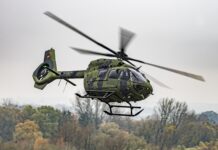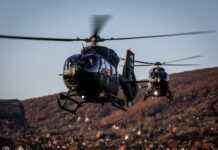Throughout history, the pace of the battlefield has always increased in line with technology. As in the last century, and as foreseen for the near future, progress in technology for military rotary aircraft, will focus on carrying capacity, weapons, and the capability to cover long distances.
European Legacy Craft
The battlefield utility rotorcraft platforms currently available to NATO members are predominantly of the 1960s/1970s/1980s legacy design concepts. They include the heavy-lift twin-rotor Boeing CH-47D (and more recently the F variant) Chinook, and the twin-engine Sikorsky CH-53G/GS/G Stallion, and three-engine CH-53E Super Stallion (and newer three-engine CH-53K King Stallion). In the medium-lift category, there are the twin-engine family of the Lockheed Martin owned Sikorsky UH-60A/L/M Blackhawk, the S-70i International Blackhawk, and the Bell-Boeing V-22 Osprey tilt rotor.

Credit: NGRC Programme Office
In European service are the Airbus Helicopters SA330 Puma, and the AS332M/532/EC725/H215M/225M Cougar/Caracal series (derived from the Super Puma), the multinational NHIndustries NH90 TTH (Tactical Transport Helicopter), and the three-engine Leonardo AW101 Merlin. In the former Warsaw Pact countries, there are also the old Russian Helicopters Mi-8 and Mi-17, (NATO codename: Hip), though the Czech Republic is in the process of replacing their Hip helicopters with the smaller Bell UH-1Y Venom or Yankee Huey, already in service with the United States Marine Corps (USMC). Bell have been targeting the Eastern Europe market over the last decade offering the Bell UH-1Y and Bell 210 Super Huey to replace legacy Russian Helicopters fleets. The Russian invasion of Ukraine has not only cooled interest in Russian Helicopters, but has drastically reduced support for the likes of the Mi-8 and Mi-17.
In France, most of the fleet consists of the smaller Airbus Helicopters twin-engine AS565F/AS365N3 Panther, the twin-engine light AS555 Fennec, and the legacy single-engine SA341/342 Gazelle HOT anti-armour and observation helicopters. These are due to be replaced with the twin-engine H160M Guépard under the hélicoptère interarmées léger (HIL) programme over the next few years and into the next decade.
In October 2022, the Chief of Staff of the Italian Air Force (Aeronautica Militare), General Luca Goretti, stated that he was keen to partner with Sikorsky, with their X2 high-speed rotorcraft technology, for the next generation of high-speed rotorcraft platforms, which he said their military urgently needs. He also noted that the Aeronautica Militare and their Navy (Marina) were already partnering with Lockheed Martin on the F-35A conventional take-off and landing (CTOL) and the F-35B short take-off and vertical landing (STOVL) naval variant, implying the Sikorsky partnership would be a natural progression. Two months after General Goretti’s announcement, the US Army selected the Bell V-280 tilt rotor for the future vertical lift (FVL) programme, over the Sikorsky-Boeing SB-1 Defiant coaxial contra-rotating push propeller design.
The SB-1 utilises the X2 high-speed technology, which has been around since 2008 with the first flight of the small two-seat X2 demonstrator. Subsequently in 2010, the X2 demonstrator broke the world speed record for rotorcraft. With the launch of the Army’s Future Long-Range Assault Aircraft (FLRAA) and the Future Vertical Lift (FVL) forming part of this, the S-97 Raider demonstrator first flew in May 2015 and from there, the SB-1 was born.
High-Speed Trans-Atlantic
This was not the first time that Sikorsky had a similar experimental high-speed airframe. In the early 1970s, the company designed and flew a high-speed advancing blade concept XH-59A (Sikorsky S-69) demonstrator with similar blade configuration to the X2 technology demonstrator, and intended to eliminate the problem of retreating blade stall at high speeds by using two counter-rotating rotors. This was powered by a pair of Pratt & Whitney PT6T-3 Twin-Pac and externally mounted auxiliary Pratt & Whitney J60-P-3A engines on each side of the fuselage. The demonstrator achieved a speed of 444 km/h (240 kn). An interesting feature of the design was the gearbox, which was able to create differential rotor speed, which would provide yawing moments that did not reverse in autorotation.
After its successful maiden flight in June 1973, it unfortunately soon experienced a low-speed accident with the XH-59A landing, with the tail coming into contact with the ground and the fuselage rolling over. The programme was set back by twelve months as a result, however, a second XH-59A had been constructed and flight testing resumed in November 1974. The first prototype was rebuilt and ended up as a wind tunnel test platform at the NASA Ames Research Centre on the same site as the then Naval Air Station Moffett Field (now Moffett Federal Airfield). With the continuation of the XH-59A test programme, NASA joined the US Air Force, US Army and US Navy with the programme.

Credit: NGRC Programme Office
In terms of tilt rotor platforms, the Bell-Boeing V-22 Osprey tilt rotor is in service with the USMC flying the MV-22B, while the USAF Special Operations Command (AFSOC) operates the CV-22B. More recently, the Navy has started to introduce the CMV-22B for the carrier on board delivery (CoD) missions, replacing the 1960s legacy twin-propeller Grumman C-2A Greyhound in that role.
The V-22 Osprey has its roots in the tilt rotor legacy of the 1950s with the Bell XV-3, which first flew in August 1957. The technology matured two decades later with the development of the two-seat, side-by-side Bell XV-15 tilt rotor demonstrator (which first flew in May 1977). Later, in the 1980s, all branches of the armed forces participated in the JVX programme, which then became the V-22 Osprey, (though the Army eventually dropped out, leaving just the USMC and USAF in the programme). The USMC was the main driving force behind the V-22, as it was intended to replace the twin-rotor Boeing CH-46E Sea Knight medium assault helicopter. The V-22 programme was temporarily halted by the then Secretary of Defence, Dick Cheney in 1989, but in 1992, under the George H.W. Bush administration, it was resumed. Nearly three decades later, with the maturity of tilt rotor technology, and a decade and a half of operations, the Bell V-280 Valor was the result of the advancement of tilt rotor design.
NATO Looks to the Next Generation
Some NATO members are looking ahead to replace the aforementioned medium-lift legacy platforms around the 2030/2040 timeframe. The Next Generation Rotorcraft Capability (NGRC) programme is intended to have these nations cooperating in designing, developing and delivery of a medium multi-role battlefield helicopter. The aforementioned technologies are at the forefront of what the future needs of the ideal rotorcraft are expected to be.
As it is, NATO differentiates between three different classes of vertical lift: these include light, medium, and heavy capabilities. The difference lies in the payload to be carried. The NGRC concept phase will focus initially on medium multi-role capabilities.
It all started in November 2020 when the British, French, German, Greek, Italian defence ministers decided to launch the multinational NGRC initiative through the signature of a Letter of Intent (LoI). Subsequently, in June 2022, the same five nations, plus the Dutch, launched the concept stage of the project through a Memorandum of Understanding (MoU). The NGRC is currently at the concept stage, with the NATO Support and Procurement Agency (NSPA) acting as contracting authority on behalf of participating nations. It is expected that the number of participants will increase, with Canada set to join later in 2023.

Credit: NGRC Programme Office
In parallel with the NGRC, both the UK and the Netherlands have signed an MoU with the US Army to share information on FVL. In July 2020, the UK Minister of the Armed Forces, James Heappey, and US Secretary of the Army, Ryan McCarthy, signed a Memorandum of Agreement (MoA), on a joint modernisation of both the British and the US Army. The idea is to complement the capabilities across all arms, from 2023 to 2027, and FVL is on the list.
In the UK, the New Medium Helicopter (NMH) competition is taking place for replacing, primarily, the legacy, five-decade-old Puma HC2 medium-lift helicopter in service with the Royal Air Force (RAF). However, the NMH is also involved in replacing other assets, such as the Bell 212 Twin Iroquois, (providing the Army Air Corps support role in Brunei), and the Bell 412 Griffon (RAF Search and Rescue at RAF Akrotiri in Cyprus), and even the Army Air Corps Special Forces AS365N3 Dauphin. In the UK, all battlefield rotorcraft come under the Joint Helicopter Command (JHC), at British Army headquarters in Andover, Wiltshire. The NMH candidates are the Airbus Helicopters H175M, the Leonardo AW149, and the Sikorsky S-70i International Blackhawk.
Over a decade ago, NATO developed the Future Heavy Transport Helicopter (FHTH) programme, with the aim of replacing the two heavy-lift helicopters, the CH-47D/F and CH-53G/GS/GA, with Eurocopter (now Airbus Helicopters) being the driving force behind the FHTH. Boeing initially partnered with Eurocopter during the 2010 ILA Berlin Air Show, but shortly after, Eurocopter went it alone. Two concepts were discussed; one was a conventional main rotor and tail rotor configuration and the other was a tandem rotor heavy-lift configuration, as with the Boeing CH-47 Chinook design. The latter has triumphed but the programme has tailed off to a certain degree.
At this stage of the NGRC programme, the participating nations are ’promoting interoperability’ through the Alliance, and there will be the possibility for additional NATO members to join at the next stage, namely the development stage, projected to start in 2027-2028. Throughout the concept stage, there will be several competitions, with the first tenders set to be initiated in the summer of 2023, so industry will be closely involved, almost from the outset.
Ian Frain











